GIGABYTE Z97X-UD5H Review: Choose Your Storage Option
by Ian Cutress on May 14, 2014 9:00 AM EST- Posted in
- Motherboards
- Intel
- Gigabyte
- Z97
Scientific and Synthetic Benchmarks
2D to 3D Rendering –Agisoft PhotoScan v1.0: link
Agisoft Photoscan creates 3D models from 2D images, a process which is very computationally expensive. The algorithm is split into four distinct phases, and different phases of the model reconstruction require either fast memory, fast IPC, more cores, or even OpenCL compute devices to hand. Agisoft supplied us with a special version of the software to script the process, where we take 50 images of a stately home and convert it into a medium quality model. This benchmark typically takes around 15-20 minutes on a high end PC on the CPU alone, with GPUs reducing the time.
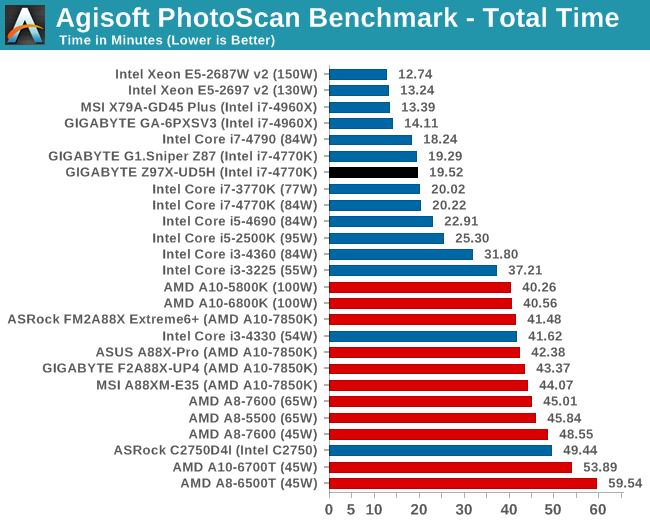
Console Emulation –Dolphin Benchmark: link
At the start of 2014 I was emailed with a link to a new emulation benchmark based on the Dolphin Emulator. The issue with emulators tends to be two-fold: game licensing and raw CPU power required for the emulation. As a result, many emulators are often bound by single thread CPU performance, and general reports tended to suggest that Haswell provided a significant post to emulator performance. This benchmark runs a Wii program that raytraces a complex 3D scene inside the Dolphin Wii emulator. Performance on this benchmark is a good proxy of the speed of Dolphin CPU emulation, which is an intensive single core task using most aspects of a CPU. Results are given in minutes, where the Wii itself scores 17.53; meaning that anything above this is faster than an actual Wii for processing Wii code, albeit emulated.
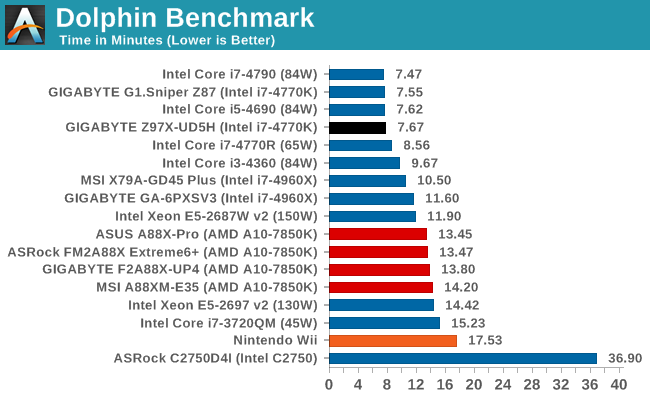
Point Calculations – 3D Movement Algorithm Test: link
3DPM is a self-penned benchmark, taking basic 3D movement algorithms used in Brownian Motion simulations and testing them for speed. High floating point performance, MHz and IPC wins in the single thread version, whereas the multithread version has to handle the threads and loves more cores.
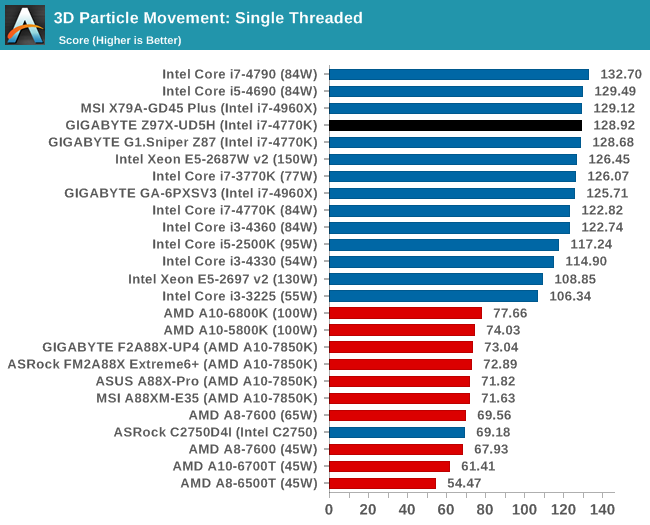
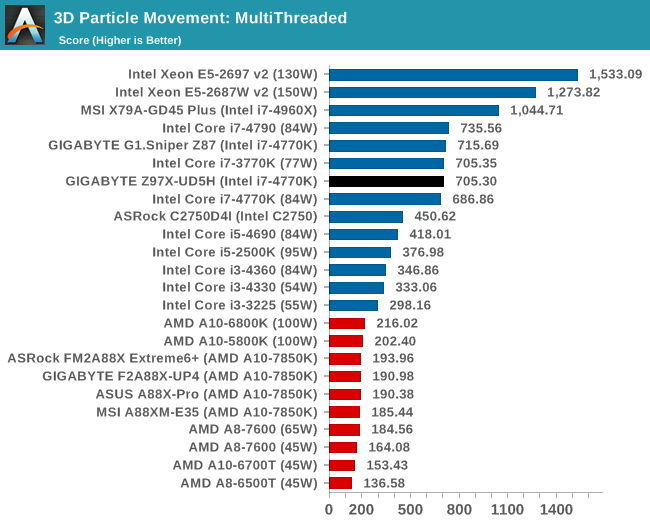
Encryption –TrueCrypt v0.7.1a: link
TrueCrypt is an off the shelf open source encryption tool for files and folders. For our test we run the benchmark mode using a 1GB buffer and take the mean result from AES encryption.
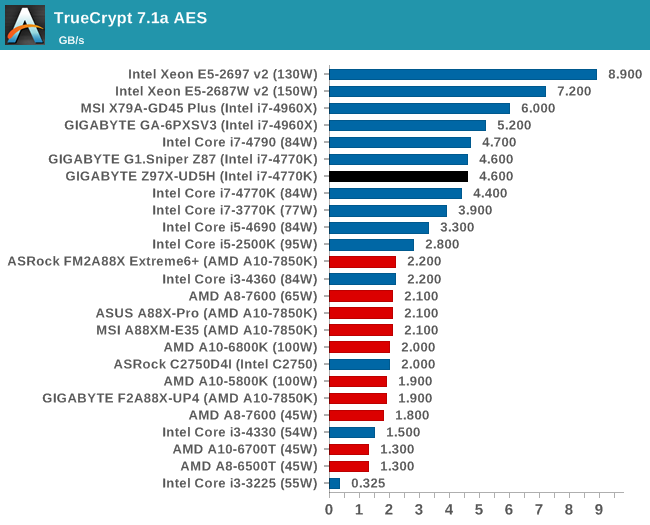
Synthetic – 7-Zip 9.2: link
As an open source compression tool, 7-Zip is a popular tool for making sets of files easier to handle and transfer. The software offers up its own benchmark, to which we report the result.
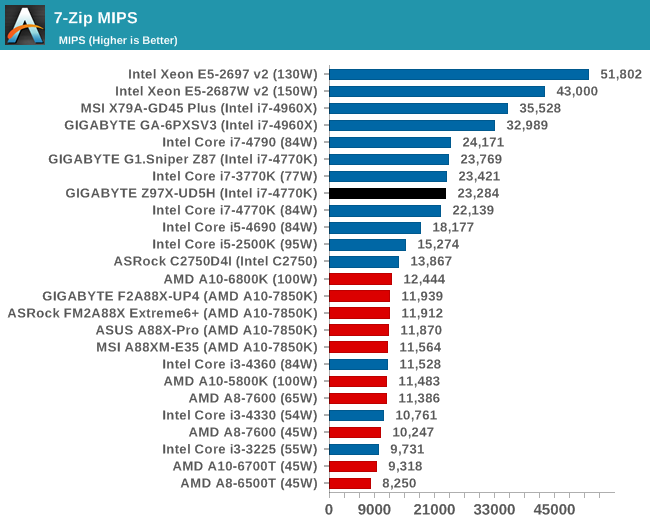










53 Comments
View All Comments
Ian Cutress - Wednesday, May 14, 2014 - link
At this point, it is more up to the motherboard manufacturer and what they implement.The chipset diagrams will show you how the slots are arranged, and which can be used at the expense of others. We will try and add these as we go forward.
As for protocols, it is all AHCI right now.
Jon-Tech - Wednesday, May 14, 2014 - link
I wanted to ask about USB controllers. Are all the USB 2.0 ports using one controller? Are the USB 3.0 ports on the same controller? Also from the sounds of it, the extra USB 3.0 ports are just using a hub rather than an extra controller? Due to my setup I often run into USB bandwidth issues with lots of ports on one controller. So I'm looking at motherboards that have as many as possible for more flexibility and none of the review sites ever seem to mention how many there are!Regarding the z97 chipset, it appears that the xHCI Host Controller supports up to 6 USB 3.0 and 14 USB 2.0, this sounds like one controller. It also has two EHCI Host Controllers which support up to 14 external USB 2.0, though it doesn't look like any of the motherboards are using these. From the sounds of it this motherboard runs all the ports off the single controller? That strikes me as being daft and therefore unlikely, could you shed any light onto what the actual USB controller set up is please? I'm also unclear on how USB affects the PCIe lanes...
repoman27 - Thursday, May 15, 2014 - link
The Z97 chipset contains one xHCI which supports 14 USB ports, up to 6 of which can be USB 3.0. It also contains 2 legacy EHCI host controllers which can be used in lieu of the xHCI for USB 2.0 ports, but there are still only external connections for 14 USB ports total.With this board, it appears that Gigabyte has connected a motherboard header and the two back panel USB 3.0 ports above the HDMI port directly to the PCH xHCI, and then used a Renesas USB 3.0 hub chip to expand an additional PCH xHCI connection to support the other four back panel ports.
The PCH is connected to the CPU via a DMI 2.0 x4 link, which is equivalent to PCIe 2.0 x4, and thus provides a maximum of 16 Gbit/s less protocol overhead of total bandwidth for all PCH attached devices. Obviously the nominal bandwidth of just 6 USB 3.0 ports is greater than that. What isn't so obvious is how the various controllers within the PCH are connected to the PCIe bus internally. From the benchmarks I've seen of previous chipsets, it would appear that the xHCI only has the equivalent of an x2 connection. This still makes it one of the fastest USB 3.0 controllers out there since the only discrete controller I know of with an x2 back end is the Etron EJ198. Seeing as most motherboard manufacturers use discrete controllers with x1 back ends and connect them to PCIe lanes coming from the PCH, the performance generally sucks. If you need more than 785 MB/s of USB 3.0 bandwidth, you'd be better off buying a card like the HighPoint RocketU 1144C and sticking it in a slot that uses some of the PEG lanes coming from the CPU.
Jon-Tech - Thursday, May 15, 2014 - link
Thanks repoman, you've been the most insightful into this from all the various places I've asked! That HighPoint card looks spot on though it's rather pricey, especially considering my old mobo has 3 controllers on it for the 2x USB 3.0 and 12x USB 2.0. Though I only know the amount of controllers cause I have it and can check.Seems the only way I'm going to actually find out controllers per motherboards is to ask owners on forums to check for me. It's a really quick test that reviewers could do and its just as annoying it's never listed in the official mobo specs! Alternatively I could buy and try them out for myself though that doesn't seem practical.
Adriak - Wednesday, May 14, 2014 - link
Why are there still (conventional) PCI slots on motherboards? Didn't they become obsolete when PCIe arrived in 2004? I understand these slots are likely added for legacy reasons, but are people still using PCI cards? What type of cards are they? Was the ISA bus supported for this long after it was effectively rendered obsolete? I am genuinely curious.Nathan539 - Wednesday, May 14, 2014 - link
This would save me some money for my new comp that im buildingpeterfares - Wednesday, May 14, 2014 - link
Are people still using PCI devices on consumer boards? What could you possibly need to add that goes into PCI for home use?fluxtatic - Thursday, May 15, 2014 - link
Sound cards. If you're not using the Asus Xonar or a Turtle Beach card, odds are good your discrete card is PCI.Luay79 - Thursday, May 15, 2014 - link
Do you lose the 16 lanes for the single video card if you use M2/SAta Express SSDs?DanNeely - Thursday, May 15, 2014 - link
No. See the block diagram at the bottom of the first page. The 16 CPU lanes go to the 16x physical slots. The M2/SataExpress connectors use lanes from the southbridge.